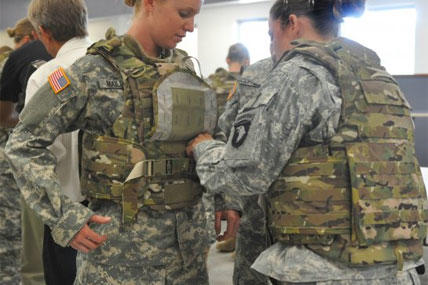If and when women assume the role of infantry soldier, one of the biggest challenges they may face is the weight on their backs, according to an official at the Veterans Health Administration.
The average female will have trouble as infantry soldiers must carry a load often weighing more than 80 pounds for many hours at a time over rugged terrain in some cases, said Dr. David Cifu, national director of physical medicine and rehabilitation at the Veterans Health Administration.
“I’m certain the majority of women doing this won’t be physically able to do it as long as the men. It’s a matter of body size and body mechanics,” Cifu said.
Women already have shown they can overcome bias and sexism, as well as engage the enemy -- they’ve been doing it in Iraq and Afghanistan. But on average, they have less body weight and are weaker than men.
A signature injury of America’s latest wars has been musculoskeletal, cases of which exceed the number of wounds from firefights and improvised explosive devices.
One study found that between 2004 and 2007, about a third of medical evacuations from the Iraq and Afghan theaters were due to musculoskeletal, connective tissue and spinal injuries.
There is no first-hand data, since women are not yet serving as infantrymen, but Cifu said that if women carry the same loads as their male counterparts, they are at more risk of these kinds of injuries “given the ratio of their size and strength to the packs.”
The Army commission that first recommended a process to get women into tactical units noted there was no plan to lower its standards.
“Qualification standards for combat arms positions should remain in place,” the commission said.
Cifu said women in general have strong legs, but are typically weaker than men in the chest, arms and lower back.
Army reports already have shown that female soldiers, even in training, sustain injuries at a higher rate than men. A study cited in “Musculoskeletal Injuries in Military Women,” noted that cumulative injury incidence among women in basic combat training was 52 percent compared to 26 percent for men. In advanced individual training, it was 30 percent for women and 24 percent for men.
These standards designate strength requirements for infantry as “very heavy” -- meaning a soldier will occasionally have to lift more than 100 pounds, but frequently or constantly be capable of lifting more than 50 pounds. In reality, infantrymen carry anywhere from 60 to 120 pounds of gear in the field depending on their job, Army officials have said.
The Army has known for years that its troops are overloaded. In 2001, the Army Science Board concluded the weight carried by soldiers decreased mobility and increased fatigue and injury. But its recommendation -- that soldiers carry no more than 50 pounds for any length of time -- has not proven possible in the field.
The Army has spent a lot of time over the last decade of war to lighten the soldier’s load. The Asymmetric Warfare Group teamed up with Johns Hopkins University in 2009 to conduct a soldier load assessment to help ease the burden of infantrymen struggling in the mountainous terrain of Afghanistan.
The effort led to Program Executive Office Soldier fielding lighter gear, such as the new body armor plate carriers, a system that is significantly lighter than the standard Improved Outer Tactical Vest.
PEO Soldier also recently began fielding body armor sized specifically for a woman’s body shape. The overdue change will allow females to carry their load more efficiently, Army officials maintain.
Despite the improvements, there are some battlefield necessities -- such as water -- that the Army can’t make lighter. It’s not unusual for dismounted infantrymen to carry six to eight liters of water on a multiple-day patrol. That adds approximately 12 to 17 pounds to an individual’s load.
Ammo also packs on the weight. A 100-round box of 7.62mm machine gun ammo weighs about seven pounds. A two-man M240 machine gun team often has to carry 1,000 rounds, or 70 pounds, for a multi-day operation, Army officials said.
This means that equipment officials will likely have to work harder if the Army expects women to succeed in the infantry. But the net result could benefit all soldiers, Cifu said.
“You need someone nimble who can avoid blasts, but have enough protection to minimize the damage [when there is one],” he said. “You need to go leaner and meaner. Infantry is going to go high tech and it will cost money, but it’s not just a woman-thing -- they’ve got to do this for all of them.”
-- Matthew Cox contributed to this report.




























